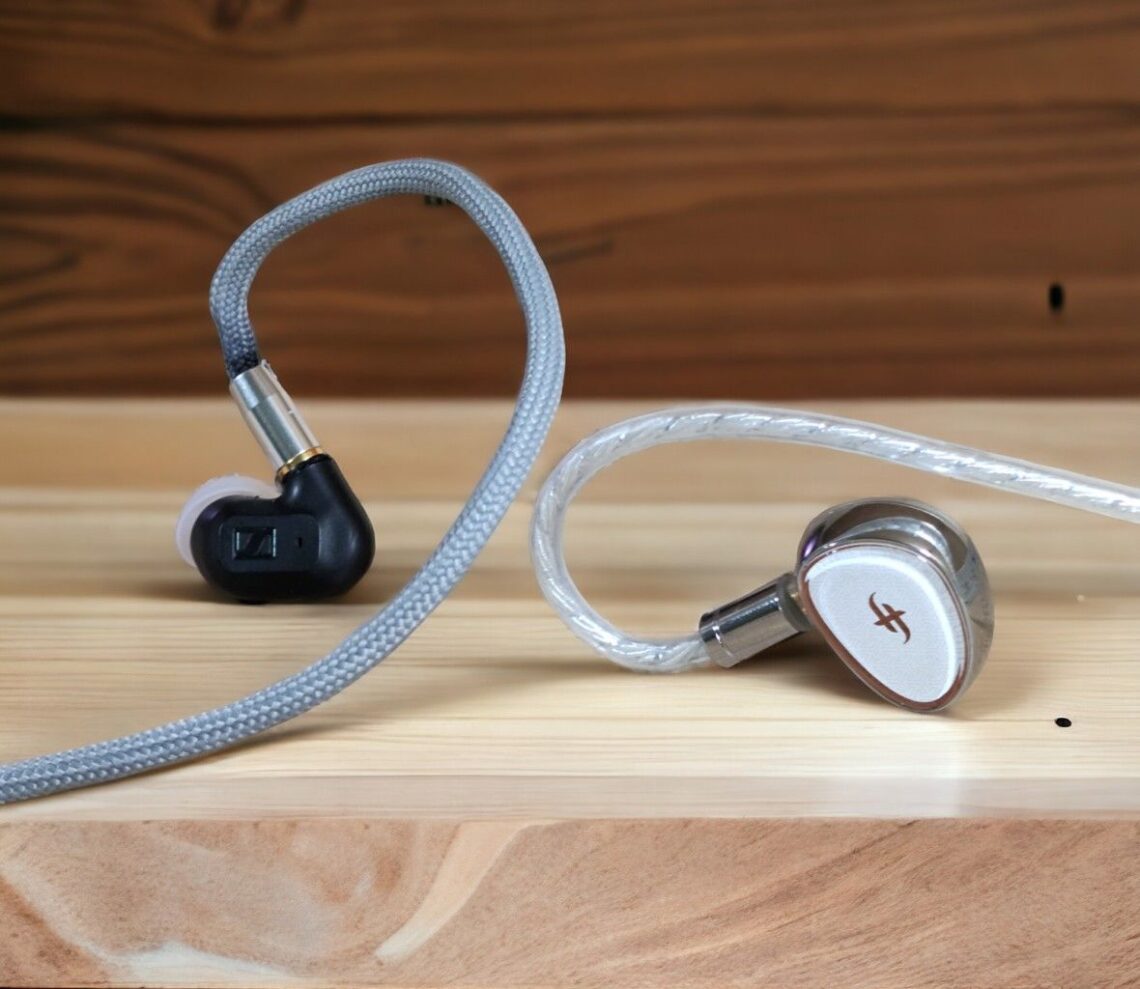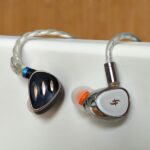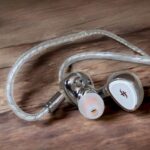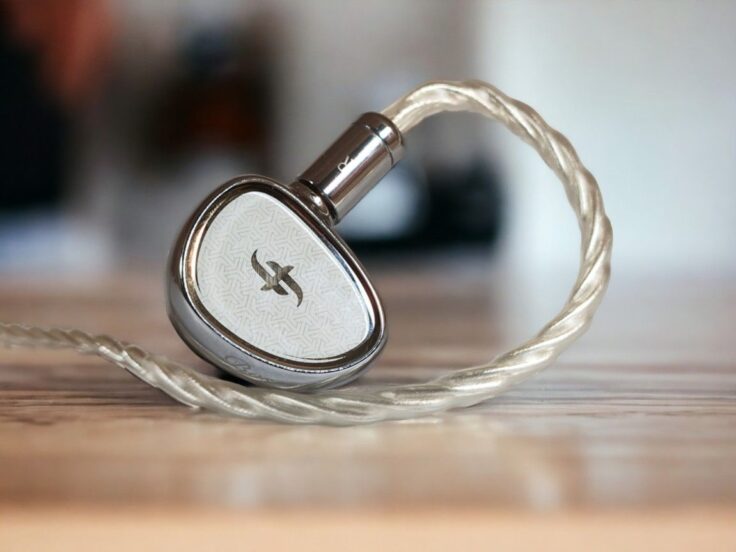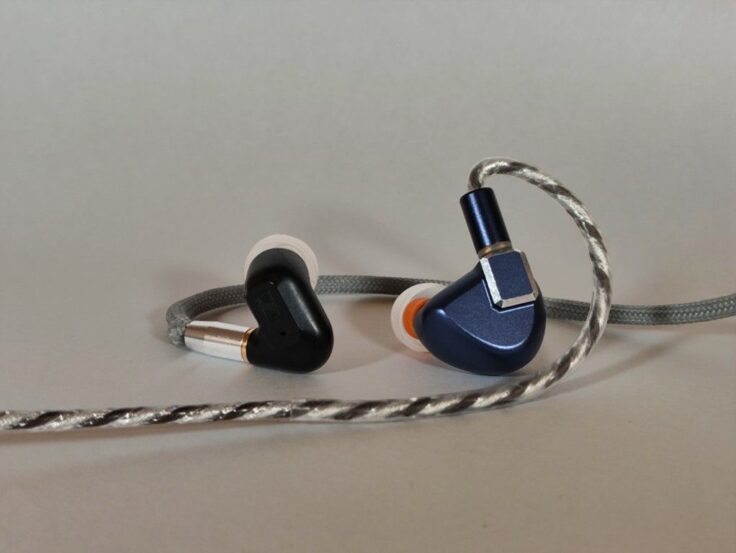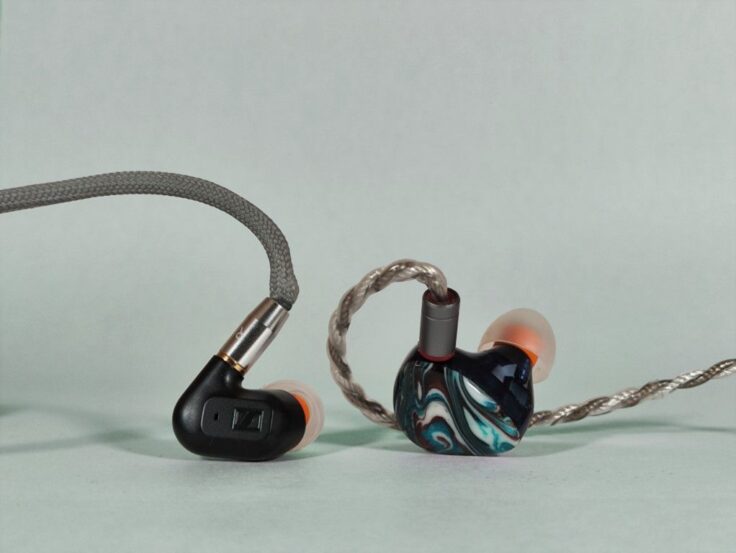This is a comparison between two in-ear monitors that have gained a reputation for being among the best in their price range. Both were launched in 2023.
The Sennheiser IE200 is a dynamic single-driver IEM. It uses the same 7 mm “True Response Transducer” (a dynamic driver) as the IE600 and the IE900, the difference between them lies mainly in the housing material and very importantly how they handle their internal acoustics. The IE200 has a black plastic body, the IE600 and IE900 are 3D printed metal. The cables and accessories are also different.
The IE200 has proprietary protruding rings around the female MMCX cable connectors. Sennheiser’s cable have MMCX connectors that fit but if you want a third party cable you must use a snap blade utility knife to cut off the protrusion in order to make room for normal male MMCX connectors. I have done this on my set in order to use a more heavy duty cable.
The supplied cable is very light and thin and has an angled connector. For my use it’s a bit impractical, thus I use a third party cable. I have tried swapping cables back and forth several times and if anything, the third party cable makes the sound a little better but not to the extent that it wouldn’t change any of my comments in this review if I had used the original cable.
The EA1000 is also a dynamic single-driver IEM. Its 10mm “Dual-Magnetic Dual-Cavity” Dynamic Driver (DD) takes care of the whole frequency spectrum. It’s set up to work in tandem with a 6mm Passive Radiator (PR), a passive diaphragm that regulates the air volume inside the housing. The EA1000 comes with 3 different types of detachable nozzles that are very effective and give 3 well-implemented tuning possibilities. It has a metal housing and is significantly larger and heavier than the IE200, but still sits nicely and comfortably in the ear.
The EA1000 comes with 3 very effective tuning nozzles. I’ll elaborate on the tuning nozzles in my separate review of the EA1000. Here’s a brief description:
- Nozzle 1 (Steel with Red Ring) is the one mounted on the EA1000 when you get it, and often the one used in reviews. It’s relatively bass-heavy with mellow highs and mids. This is my least preferred tuning, personally.
- Nozzle 2 (Golden Brass with Clear Ring) has less bass and a relatively brighter-sounding treble along with more relative midrange presence. This is the nozzle used here in my comparison with the IE200. It’s also my favourite all-round choice.
- Nozzle 3 (Steel with Black Ring) has a very neutral bass, a crisper treble – along with an upfront midrange. I like this tuning quite a lot too.
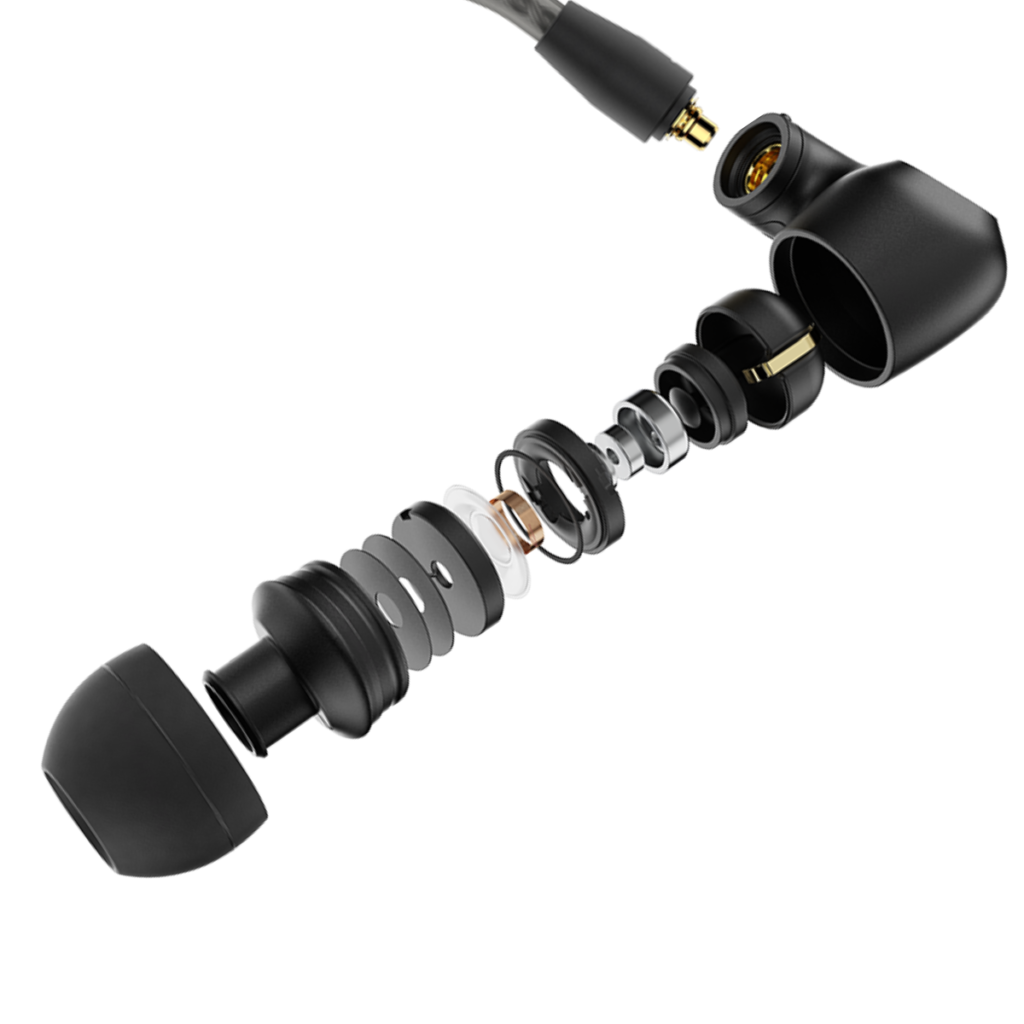
SENNHEISER IE200 SPECIFICATIONS
- Single dynamic 7mm extra-wideband True Response transducer, the same as in the IE 300, IE 600 and IE 900.
- Frequency range: 6 – 26,000 Hz.
- Impedance: 18 Ohm.
- Sound pressure level: 119 dB.
- 1.2 m MMCX cable.
- 3.5 mm stereo mini jack (angled, gold-plated)
- Braided cable with MMCX connectors and 3.5mm plug
- Adjustable ear hooks and choice of ear tip adapters.
Check the price on Amazon: Sennheiser IE200
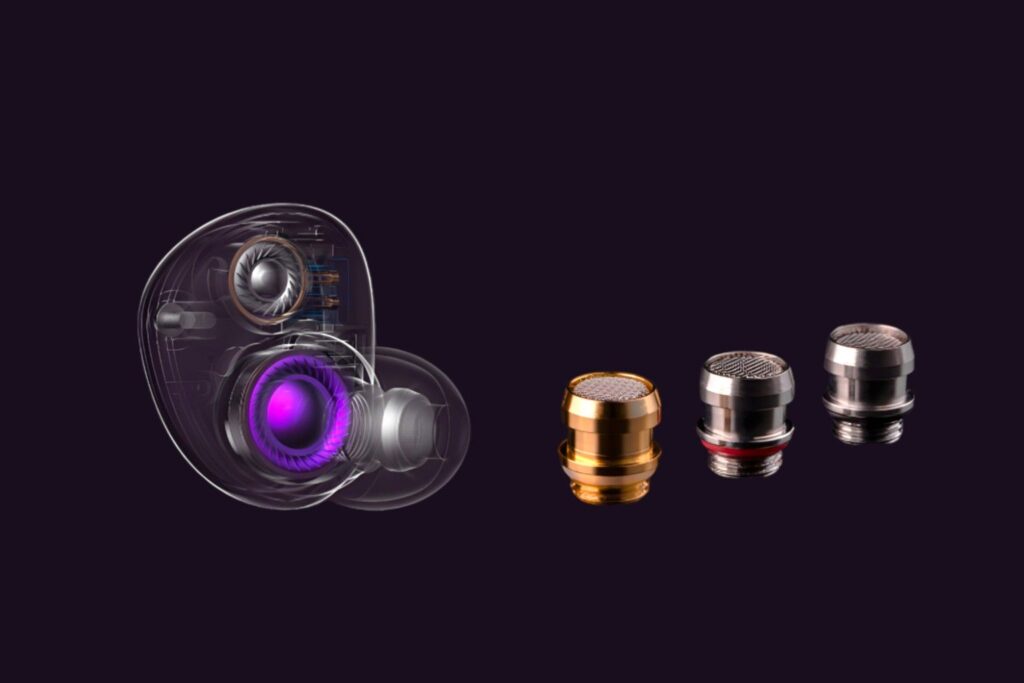
SIMGOT EA1000 SPECIFICATIONS
- Driver: 10mm Dual-Magnetic & Dual-Cavity Dynamic Driver, 1 Passive Radiator
- Diaphragm: Multi-Layer Sputter Deposition Purple-Gold Diaphragm
- Impedance: 16 Ohms ±15% (@1kHz)
- Sensitivity: 127 dB/Vrms (@1kHz)
- Frequency Response: 10Hz-50kHz
- Effective Frequency Response: 20Hz-20kHz
- Included Detachable Cable: 120 cm Silver-Plated OFC Litz Cable
- Cable plug: 3.5mm
- Attachment plugs IEM: 0.78mm 2 pin
- 3 pairs of tuning nozzles included
Check the price in Linsoul: Simgot EA1000
Check the price on Amazon: Simgot EA1000
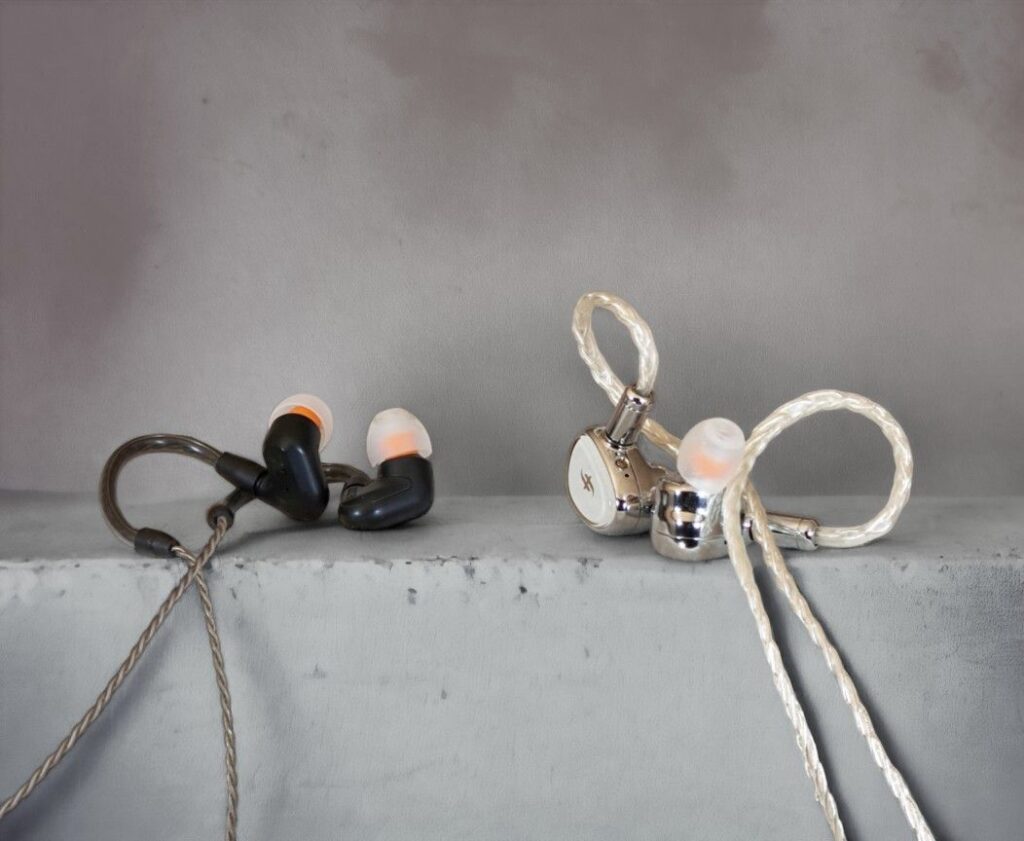
COMPARISONS
The EA1000 has golden brass tuning nozzles installed, the most balanced sounding of the three options.
I used the Topping A90 amp and the RME ADI-2 DAC FS as a source. I use the powerful and neutral desktop amplifier to ensure that none of the earphones are limited by insufficient amping.
Jambi by Tool
The bass is wonderfully textured and extremely well-defined with the IE200. It’s really punchy and has just the right amount of body. The tonal balance is very good.
The EA1000 has a similar tonal balance. The bass is a bit less tight, but similarly full. The EA1000 sounds more rounded and organic.
Smile by Pearl Jam
The IE200 has sharper edges and separation and nice texture on the fuzz guitars. It is bordering on sibilance with Eddie Vedder’s S-es but it’s not a problem, just almost.
The EA1000 is fuller, rounder and slightly warmer sounding. There’s more tonal weight and body. The details are posted in a more liquid manner. The EA1000 has no issue with sibilance, it’s not even close.
Almost Like the Blues by Leonard Cohen
The IE200 sounds great. The bass is punchy, the rattle is crisp, the piano has great reverb. Cohen’s voice is beautifully rendered. It’s warm, yet well textured.
The EA1000 also sounds great. It’s a bit less sharp around the edges. However, there’s detail in abundance. The bass is both a bit stronger and fuller than with the IE200. The treble is less crisp, it’s more liquid.
Black Crow by Cassandra Wilson
The IE200 offers great separation. The vocals are allowed to take centre stage. The bass drums are relatively tight, the percussion crisp. The clarinet is articulate and easy to separate. The sound stage is quite airy, and the imaging is great.
The EA1000 offers better defined bass that sounds less boomy. There is a smoother, slightly lusher sound. Everything is well defined, but not as sharp as with the IE200. The presentation is extremely coherent.
Some Day My Prince Will Come by Coryell-Coryell-Vitous Quartet
The IE200 has great separation, a warm tonality and generally a very nice presentation. The bass is well-defined. The electric guitar is very detailed, there are subtle ambient background sounds that actually make me turn my head.
The EA1000 sounds very good too. It is just as detailed sounding but again it is in a different way. The timbre is more natural, and rounder. There is more fluidity in the way the music is rendered. It is not as crisp sounding as the IE200, but all the details are there. The bass is a bit stronger but it is very well-behaved.
Bored by Deftones
The fuzz guitars have very nicely rendered textures and sound full and crisp with the IE200. The bass is very good, full but well-defined and not too bloomy. Vocals are presented nicely separated from the rest, the layering is excellent.
The EA1000 sounds great too. However, the separation isn’t as sharp, the textures aren’t as crisp.
As Before by Olga Konkova
With the IE200, the cajôn drum is punchy, the piano crisp and clear, but slightly shrill. The highest tones can be unpleasant. Vocals are good but lack a bit of body. There is good separation.
The EA1000 has a more coherent and organic presentation. The cajôn bass drum is full and punchy, the vocals are very present and tender, the piano is clear but never edgy.
Spontanius Compositorius by Thomas Agergaard
Starting with the EA1000 here, and it sounds completely fabulous. The saxophone is organic and very present. The sparkly and crisp percussion is never sibilant, shrill or harsh. The bass might be a bit stronger than I would mix it, but is well-controlled and has good definition.
The IE200 presents the saxophone a bit dry, the percussion is a tad shrill and too crisp sounding. The bass is a bit bloomy. The separation of the instruments and general imaging is very good, though.
Young Vivaldi Violin Concerto RV813 III by Ensemble Modo Antiquo
With the IE200, the strings are very well-defined and have lots of texture and a dry sense of warmth. Good separation between the instruments and the sound stage is nice and wide. The treble is crisp and clear without becoming shrill.
The EA1000 presents the strings in a very organic manner. The textures are a bit rounder than with the IE200, but there is at least as much information. The treble is not as crisp but more liquid and very enjoyable. There is more tonal weight and body. The space between instruments is not as well defined as with the IE200, but it is still easy to separate each instrument in the mix and follow every melody line.
Mahler’s Symphony No. 2 III by Paavo Järvi
Starting with the IE200, the kettle drums are very powerful and tight with lots of definition. You can hear the drum skin resonating. The strings have a lot of texture and nuance. The space between instruments is well-defined. The sound stage is huge and the imaging is great.
With the EA1000, it sounds a bit different but in a good way. The kettledrums are also very powerful here and the reverb is very audible. The sound stage is very large and even though the instruments are not as well separated as with the IE200, the imaging is great. There is a sense of liquidity and flow to the music that is completely mesmerizing. Everything has lots of detail and nothing has very sharp edges or gets harsh and shrill.
Escape Route by Boris Blank
With the IE200, the bass is full-bodied and punchy. The sound stage is wide, separation is very good. The sound is well balanced across the frequency spectrum and everything is well articulated and details stand out nicely.
The EA1000 is also very spacious and dynamic sounding, but it is not this articulate and the separation is not as impressive as with the IE200. However, all the detail is there, and it has a very nice, effortless flow that just makes you want to lean back and listen more and more.
Follow by BMX
With this delicious and toned-down improvisational jazz track, the IE200 is very spacious sounding and all the little sounds from the various percussion in the beginning are well articulated. The sound is crisp and clear. The imaging is great. When the saxophone and the trumpet enter, they have lots of texture but can sound slightly dry.
With the EA1000, the saxophone and the trumpet sound very natural and organic. The sound is very spacious and everything is very well defined. There is more weight to the individual sounds and tones than with the IE200. The presentation feels very effortless. Everything is very well balanced and the treble has lots of fine detail without sounding too crisp. There is a great sense of depth in the presentation and the imaging is generally very well executed.
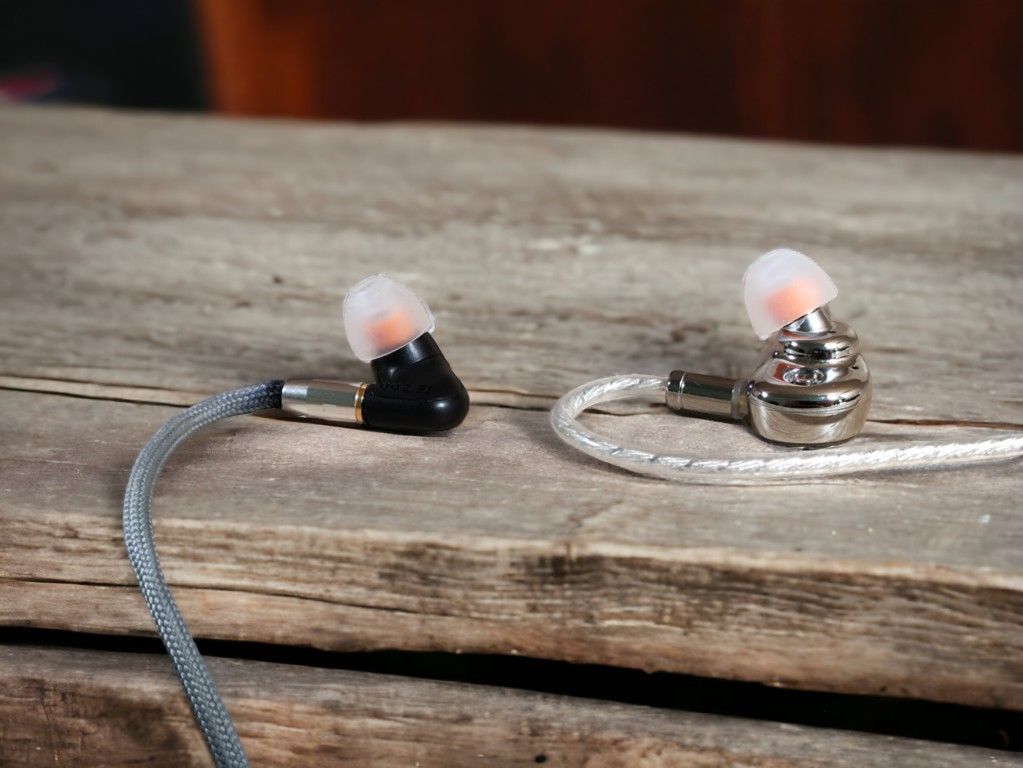
WRAPPING IT UP
Sound Signature
In terms of tonal balance, they are not too far apart. Both come off as relatively neutral and to me very natural sounding. The IE200 has comparably a bit less prominent midrange and a more pronounced and crisp high-end that sometimes gets a bit too much for my tender ears. The EA1000 has a little bit more bass presence and definitely is more prominent in the mid-range. The treble is not as crisp but it is very detailed and there is lots of nuance.
Dynamics and Detail
I find both to be dynamic-sounding. However, the IE200 might be a bit more dynamic both in terms of micro- and macro-dynamics. There’s slightly more dynamic contrast. That does not mean that the EA1000 is lacking in the dynamics-department, because it too is really good.
With regards to detailed retrieval, they are a bit different in the way they render the music. The IE200 is crisper and dryer sounding with the result that textures are more obvious and details sound a bit more articulate. The EA1000 on the other hand has even more fine detail but it is presented in a very liquid and organic way that I personally find very fascinating.
Treble
The IE200 has a very crisp and clear treble but it can sometimes be a bit too bright and sibilance can be an issue. Sibilance or shrillness is never an issue with the EA1000, which has a much more rounded treble that sounds very effortless and liquid.
Midrange
Both have a nice midrange but the EA1000 has more midrange body and comes off as a bit warmer and definitely fuller sounding. The IE200 again can sound a bit more textured but it does not contain any more information than EA1000, rather the opposite.
Bass
They both have good bass quantity and quality. The EA1000 is a bit fuller sounding but still offers great definition and they are both punchy and dynamic sounding.
Sound Stage and Imaging
Both have a very wide soundstage, but the IE200 is the widest sounding. It also has the most precise imaging. However, the EA1000 is by no means a narrow-sounding earphone and it is definitely good at instrument separation and layering as well as image depth. The tonal weight is just more prominent, in other words, the IE200 sounds a bit thinner.
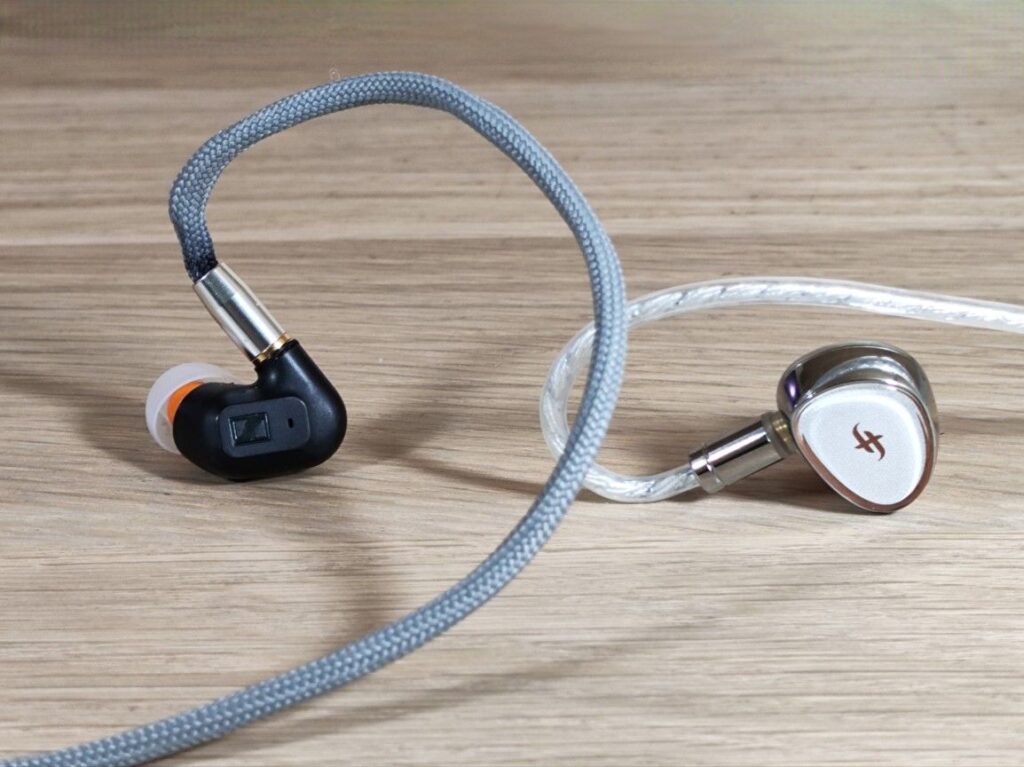
CONCLUSION
These are both excellent IEMs with many similarities but also with some distinct differences. The IE200 excels with good dynamic contrast and strong articulation of details and texture. The EA1000 offers a more refined detail presentation. It has an effortless and very liquid yet full-bodied and energetic way of rendering the music that I find extremely appealing.
Buy on Linsoul: Simgot EA1000
Buy on Amazon: Simgot EA1000
Buy on Amazon: Sennheiser IE200
We make earnings through affiliate links and any purchase you make on Amazon or Linsoul clicking one of our links will give us a small provision at no cost to you.
We only get a provision for items that are not returned, so there’s no incentive for us to recommend something that’s not good.
Linsoul : Headphones, Earbuds, Wireless Earbuds, Desktop DAC/AMP, Portable DAC/AMP, Digital Audio Players,
Amazon: Headphones, IEMs, Headphone Amplifiers, Home Audio or Anything else.
.
If you enjoyed this article or other content on The Headphoneer, you might consider leaving a small donation to keep this website up and running. No donation is too small. Thanks for supporting us!
If you like our work please follow us on Instagram, Facebook and Twitter , it will help us grow. Sharing is caring 🙂


